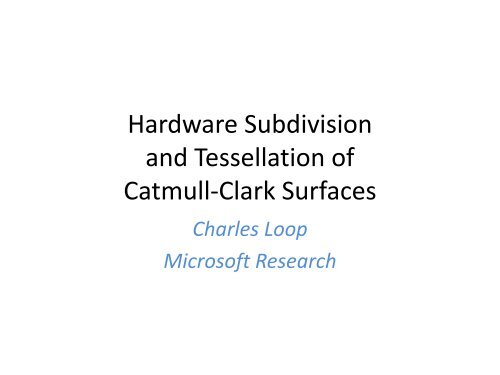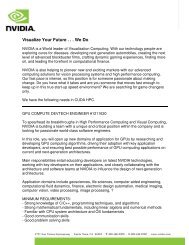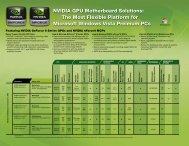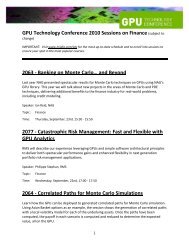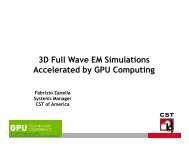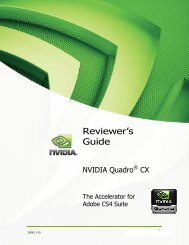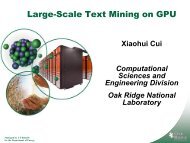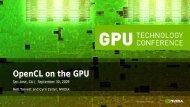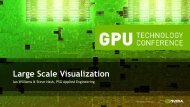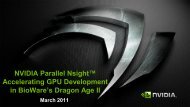Hardware Subdivision and Tessellation of Catmull-Clark Surfaces
Hardware Subdivision and Tessellation of Catmull-Clark Surfaces
Hardware Subdivision and Tessellation of Catmull-Clark Surfaces
Create successful ePaper yourself
Turn your PDF publications into a flip-book with our unique Google optimized e-Paper software.
<strong>Hardware</strong> <strong>Subdivision</strong><br />
<strong>and</strong> <strong>Tessellation</strong> <strong>of</strong><br />
<strong>Catmull</strong>-<strong>Clark</strong> <strong>Surfaces</strong><br />
Charles Loop<br />
Micros<strong>of</strong>t Research
• DirectX 11 Pipeline<br />
• <strong>Subdivision</strong> <strong>Surfaces</strong><br />
Outline<br />
• Gregory Patch Approximation<br />
• GPU <strong>Subdivision</strong>
Input Assembler<br />
Vertex Shader<br />
Hull Shader<br />
Tessellator<br />
Domain Shader<br />
Geometry Shader<br />
Rasterizer<br />
Pixel Shader<br />
Output Merger<br />
DirectX 11 Pipeline<br />
Data<br />
Compute Shader
• GPGPU-Computing<br />
• Single shared context<br />
• Cuda-like<br />
– HLSL Syntax:<br />
DX Compute<br />
[numthreads(8, 1, 1)]<br />
void Copy(uint3 blockIdx : SV_GroupID,<br />
uint3 DTid : SV_DispatchThreadID,<br />
uint3 threadIdx : SV_GroupThreadID,<br />
uint GI : SV_GroupIndex )<br />
{<br />
Output[8*blockIdx.x + threadIdx.x] =<br />
Input[8*blockIdx.x + threadIdx.x];<br />
}<br />
Compute Shader
<strong>Hardware</strong> <strong>Tessellation</strong> Pipeline<br />
• Three new pipeline stages<br />
– Hull Shader (programmable)<br />
– Tessellator Unit (configurable)<br />
– Domain Shader (programmable)<br />
Input Assembler<br />
Vertex Shader<br />
Hull Shader<br />
Tessellator<br />
Domain Shader<br />
Geometry Shader<br />
Setup/Raster
• Transform input control points<br />
• One thread per output point.<br />
• Hull Shader Constant Function<br />
– Compute edge <strong>and</strong> inside<br />
tessellation factors<br />
Hull Shader (HS)<br />
Input Assembler<br />
Vertex Shader<br />
Hull Shader<br />
Tessellator<br />
Domain Shader<br />
Geometry Shader<br />
Setup/Raster
Tessellator (TS)<br />
• Fixed function stage, configurable<br />
• Domains:<br />
– tri, quad, isoline<br />
• Spacing:<br />
– integer, fractional, pow2<br />
Input Assembler<br />
Vertex Shader<br />
Hull Shader<br />
Tessellator<br />
Domain Shader<br />
Geometry Shader<br />
Setup/Raster
Tessellator (TS)<br />
Level 5 Level 5.4 Level 6.6
Left = 3.5<br />
Right = 4.4<br />
Bottom = 3.0<br />
Top,Right = 4.5<br />
Bottom,Left = 9.0<br />
Tessellator (TS)<br />
Inside Tess:<br />
minimum<br />
Inside Tess:<br />
average<br />
Inside Tess:<br />
maximum
Bitwise Consistent Evaluation<br />
• Patches share boundaries<br />
– Coincident vertices evaluated via different code paths<br />
– Floating point addition non-commutative<br />
Solution: symmetric or order consistent evaluation<br />
• References http://developer.nvidia.com
<strong>Subdivision</strong> <strong>Surfaces</strong>
<strong>Catmull</strong>-<strong>Clark</strong> <strong>Subdivision</strong><br />
<strong>Catmull</strong>, E. AND <strong>Clark</strong>, J. 1978,<br />
Recursively generated B-spline surfaces on arbitrary topological meshes<br />
subdivision
Problem: Infinite number <strong>of</strong> patches<br />
subdivision<br />
• Poor fit to hardware tessellation paradigm<br />
•<br />
Stam, J. 1998,<br />
Exact evaluation <strong>of</strong> <strong>Catmull</strong>-<strong>Clark</strong> subdivision surfaces at arbitrary<br />
parameter values<br />
• Exact evaluation is possible, but slow
Approximate <strong>Subdivision</strong> <strong>Surfaces</strong>
Approximate <strong>Subdivision</strong> <strong>Surfaces</strong><br />
Loop, C. , Schaefer, S. Ni, T., AND Castaño, I. 2009,<br />
Approximating subdivision surfaces with Gregory patches for tessellation hardware
Geometric Construction
Patch Construction<br />
Gregory patches in 1-1 correspondence<br />
with control mesh faces<br />
• General construction for<br />
3 or 4 sided faces
Implementation
Implementation<br />
Two Approaches
Hull Shader Stencil Approach<br />
• Cluster mesh faces by neighborhood type<br />
– permutation <strong>of</strong> a face 1-ring neighborhood<br />
– draw call per neighborhood type<br />
• Neighborhood determines a stencil matrix<br />
– hull shader computes matrix/vector product
Two GPU Approaches<br />
• Vertex/Hull Shaders<br />
– Exploit vertex-centric nature <strong>of</strong> computations<br />
– 3 or 4 point patch primitives<br />
– Fat vertices<br />
• Hull Shader Stencil Approach<br />
– Map patch construction to hull shader exclusively<br />
– 6 to 32 point patch primitives<br />
– Thin vertices
Results
More Results
GPU <strong>Subdivision</strong>
Hybrid SubD/Tess Data Flow<br />
Mesh Data<br />
Compute Shader<br />
Input Assembler<br />
Vertex Shader<br />
Hull Shader<br />
Tessellator<br />
Domain Shader<br />
Geometry Shader<br />
Rasterizer<br />
Pixel Shader<br />
Output Merger<br />
Data-Parallel<br />
<strong>Catmull</strong>-<strong>Clark</strong><br />
<strong>Subdivision</strong><br />
DirectX 11<br />
<strong>Tessellation</strong><br />
Pipeline
<strong>Subdivision</strong> with <strong>Tessellation</strong><br />
• Simplifies Mesh Connectivity<br />
– Quad mesh, isolated extraordinary vertices<br />
– Reduces hull shader matrix combinations<br />
– Enables more clustering, fewer draw calls<br />
• Performance/Quality Trade<strong>of</strong>f<br />
– Stam’s direct evaluation procedure<br />
– Curvature continuous patching<br />
– More accurate Gregory approximation
Data-Parallel <strong>Subdivision</strong>
<strong>Subdivision</strong> Tables
[numthreads(8, 4, 1)]<br />
void FacePoint(uint3 blockIdx : SV_GroupID,<br />
uint3 DTid : SV_DispatchThreadID,<br />
uint3 threadIdx : SV_GroupThreadID,<br />
uint GI : SV_GroupIndex )<br />
{<br />
int FaceIdx = 8 * blockIdx.x + threadIdx.x;<br />
}<br />
if (FaceIdx < F0){<br />
int h = F0_ITa[2*FaceIdx];<br />
int n = F0_ITa[2*FaceIdx+1];<br />
}<br />
Face Kernel<br />
float q = 0.0f;<br />
for (int j=0; j
[numthreads(8, 4, 1)]<br />
void EdgePoint(uint3 blockIdx : SV_GroupID,<br />
uint3 DTid : SV_DispatchThreadID,<br />
uint3 threadIdx : SV_GroupThreadID,<br />
uint GI : SV_GroupIndex )<br />
{<br />
int EdgeIdx = 8 * blockIdx.x + threadIdx.x;<br />
}<br />
if (EdgeIdx < E0){<br />
float q = 0.25f*(<br />
VB[SRC_OFFSET + 4*E0_IT[4*EdgeIdx+0] + threadIdx.y] +<br />
VB[SRC_OFFSET + 4*E0_IT[4*EdgeIdx+1] + threadIdx.y] +<br />
VB[SRC_OFFSET + 4*E0_IT[4*EdgeIdx+2] + threadIdx.y] +<br />
VB[SRC_OFFSET + 4*E0_IT[4*EdgeIdx+3] + threadIdx.y] );<br />
}<br />
Edge Kernel<br />
VB[DEST_OFFSET_2 + 4*EdgeIdx + threadIdx.y] = q;
[numthreads(8, 4, 1)]<br />
void VertexPoint(uint3 blockIdx : SV_GroupID,<br />
uint3 DTid : SV_DispatchThreadID,<br />
uint3 threadIdx : SV_GroupThreadID,<br />
uint GI : SV_GroupIndex)<br />
{<br />
int VertexIdx = 8 * blockIdx.x + threadIdx.x;<br />
}<br />
if (VertexIdx < V0){<br />
int h = V0_ITa[2*VertexIdx];<br />
int n = V0_ITa[2*VertexIdx+1];<br />
}<br />
Vertex Kernel<br />
float q = 0.0f;<br />
for (int j=0; j
Tessellator Pipeline Stage
Domain Shader<br />
float u[4], du[4];<br />
float3 uB[4], duB[4];<br />
CubicBezier(uv.x, u, du);<br />
for (uint i = 0; i < 4; i++) {<br />
uB[i] = float3(0, 0, 0);<br />
duB[i] = float3(0, 0, 0);<br />
}<br />
for (uint j = 0; j < 4; j++) {<br />
float3 A = B[4*i + j];<br />
}<br />
uB[i] += u[j] * A;<br />
duB[i] += du[j] * A;<br />
float3 WorldPos = float3(0, 0, 0);<br />
float3 Tangent = float3(0, 0, 0);<br />
float3 BiTangent = float3(0, 0, 0);<br />
CubicBezier(uv.y, u, du);<br />
for (i = 0; i < 4; i++) {<br />
WorldPos += uB[i] * u[i];<br />
Tangent += duB[i] * u[i];<br />
BiTangent += uB[i] * du[i];<br />
}
Basis Functions<br />
void CubicBezier(in float u, out float b[4], out float d[4])<br />
{<br />
float t = u;<br />
float s = 1.0 - u;<br />
}<br />
float a0 = s * s;<br />
float a1 = 2 * s * t;<br />
float a2 = t * t;<br />
b[0] = s * a0;<br />
b[1] = t * a0 + s * a1;<br />
b[2] = t * a1 + s * a2;<br />
b[3] = t * a2;<br />
d[0] = - a0;<br />
d[1] = a0 - a1;<br />
d[2] = a1 - a2;<br />
d[3] = a2;
Results
<strong>Subdivision</strong> Stage<br />
GPU Twohole Bigguy Cat<br />
Radeon 5870 0.30 0.31 0.35<br />
GTX 480 0.33 0.36 0.48<br />
time in milliseconds
frames per second<br />
1200<br />
1000<br />
800<br />
600<br />
400<br />
200<br />
0<br />
Twohole<br />
Radeon 5870 GTX 480<br />
2 4 8 16 32 64 2 4 8 16 32 64<br />
tess factor<br />
Gregory VH<br />
Gregory HS<br />
Gregory HS subd<br />
Stam<br />
Biseptic
frames per second<br />
1200<br />
1000<br />
800<br />
600<br />
400<br />
200<br />
0<br />
Bigguy<br />
Radeon 5870 GTX 480<br />
2 4 8 16 32 64 2 4 8 16 32 64<br />
tess factor<br />
Gregory VH<br />
Gregory HS<br />
Gregory HS subd<br />
Stam<br />
Biseptic
frames per second<br />
1200<br />
1000<br />
800<br />
600<br />
400<br />
200<br />
0<br />
Cat<br />
Radeon 5870 GTX 480<br />
2 4 8 16 32 64 2 4 8 16 32 64<br />
tess factor<br />
Gregory VH<br />
Gregory HS<br />
Gregory HS subd<br />
Stam<br />
Biseptic
Conclusions<br />
• Approximation is fastest<br />
– ideal for displacement mapping<br />
• GPU mesh subdivision is fast<br />
– memory needs impractical for deep subdivision<br />
– tessellation big win for dense sampling<br />
• Hybrid subd/tess is interesting<br />
– complexity reduction<br />
– speed/accuracy/quality knob
Thanks!


